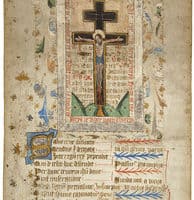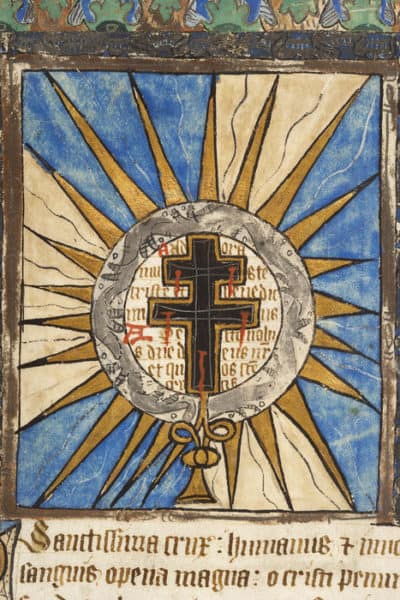I came across an article from EurekAlert about a recent study of a Prayer Roll from, or perhaps more accurately, devoted to the medieval Norfolk shrine of the Holy Rood of Bromholm Priory. It appears to date from the early sixteenth century, when the penultimate Prior, John Underwood, was titular Bishop of Chalcedon as an assistant to the Bishop of Norwich between 1505 and 1535. Only recently has it attracted scholarly attention. The article can be seen at Publication of 500-year-old manuscript exposes medieval beliefs and religious cults
The full, illustrated, Journal of the British Archaeological Association article can be seen at An Early-16th-Century Prayer Roll and the Holy Rood of Bromholm
The Mail Online also has a good synopsis with illustrations at 500-year-old prayer roll describes Christian practices in England
There are similar articles from ScienceBlog at Publication of 500-year-old manuscript exposes medieval beliefs and religious cults and from Science alert at 500-Year-Old Illuminated Prayer Roll Reveals Insights Into The 'Cult of The Cross'

The Cluniac priory of St Andrew at Bromholm - Broom Island - was at Bacton on the north-east coast of Norfolk Founded in 1113 from Castle Acre in the western part of the county and independent from 1298. In 1205 this impoverished house received the Holy Rood, given by a priest in return for admission to the community for himself and his two sons. The relic was loot from the sack of Constantinople the previous year by members of the army of the Fourth Crusade, and it was seen to work miracles.
Heritage England has an account of the history and archaeology of the site at Bromholm Priory ruins, Bacton
Norfolk Tales, Myths and More also has a detailed, illustrated, history of the priory and its great relic at Bromholm Priory – Time Dependant! and which cites contemporary textual evidence. This account also includes something of the history of the Paston family and their role as the local patron of the priory in the fifteenth century.
Despite the 1424 report of the Rood being thrown into a fire it appears to have survived until 1537. Indeed had it been destroyed by the apparent Lollard chaplain such an action would be more clearly remembered. Testing relics - or Holy Writ - by putting them into a fire was not unknown. The idea was that a genuinely holy item could, so as to speak, look after itself. The existence of the Prayer Roll surely indicates that the Rood which is shown on it, was still extant in the early sixteenth century.
There is a shorter article about the Rood and the pilgrimage in the Weird Norfolk series in the Eastern Daily Press at Weird Norfolk: Bringing the dead back to life at Bromholm Priory
A 1937 article about the Holy Rood by Francis Wormold can be viewed on JSTOR at The Rood of Bromholm on JSTOR
In its early years as a place of pilgrimage the priory attracted in 1223 the young, and very devout, King Henry III on a visit. The Rood was mentioned by Langland and by Chaucer in The Reeve’s Tale.
Norfolk Heritage Explorer has an online account of the archaeology of the
There is a description of the priory ruins - which appear not to be in an ideal state - at Lost in a landscape: Bromholm Priory
The North Norfolk News has a report at Remains of 12th century priory in North Norfolk draw visitors about a 2017 Open Day at the site which is on private land. The This is Paston website features a 3D reconstruction of the Priory at Bromholm Priory
This is also featured in greater detail in a 2020 BBC News illustrated report of the reconstruction and which also features the similar modelling of Paston Hall. This can be seen at Medieval Bacton priory brought to life with 3D modelling
For those interested in the history of the Paston family, the insights offered by their correspondence into fifteenth century life I would recommend H.S.Bennett’s eminently readable The Pastons and their England
The Bromholm shrine of the Holy Rood possessed some similarities to the greatest of all Norfolk shrines at Walsingham in the north-west of the county - both are remote rural settings that proved both to be centres of popular devotion and also attracted royal visits.
Scepticism as to relics of Holy Cross is by no means uncommon, but we should perhaps be sceptical about such scepticism. The vast majority of such relics are miniscule, so the size argument does not work, and they are usually authenticated by a significant religious authority. We csn never know their specific origin but to dismiss them out of hand is to be in its own way just as credulous as critics accuse the traditional faithful of being.

Another illustration of the Holy Rood from
the Prayer Roll.
The imagery references the devotion to the Five Wounds whilst setting the Rood in a monstrance. The blue and white background might be a link to the Paston family who had intermarried with the Beaufort family, who used a similar blue and white feature as a border to their arms.
Image: Gail Turner/Journal of the British Archaeological Association./ ScienceBlog
Hail Holy Cross, Our Hope!

